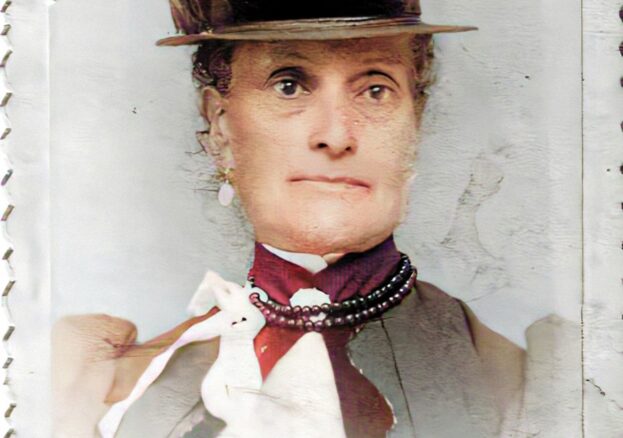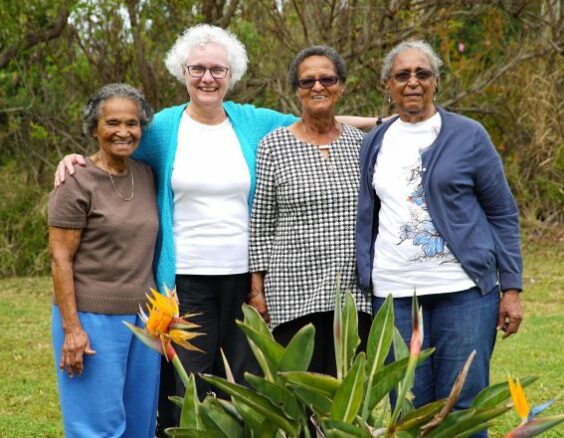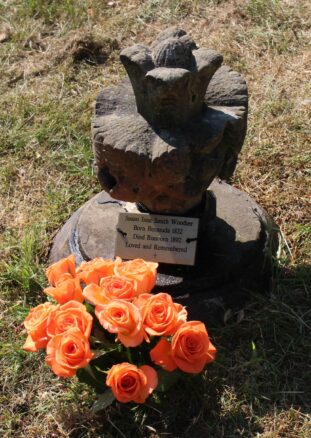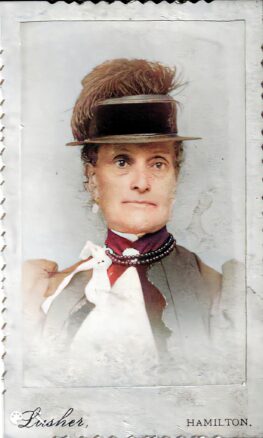
This fascinating tale was unearthed by one of her descendants, Roslyn (Ros) Macgregor, who lives in Quebec, Canada and unravelled a depressingly familiar story of poverty, hardship and exploitation.
Ros began her quest when her parents died in 1993 and 1995. She was searching for her mysterious Grandpa Macgregor, her dad’s father, who they believed, had died in a construction accident in Uruguay in 1923. However, on further investigation she found ‘grandpa’ had actually died in London in 1954. The trail sadly went cold but it led Ros to uncover other family roots that began in Bermuda.
On holiday in Bermuda with friends, she visited the island’s archives and a huge directory called ‘Hallett’s 19th Century Church Registers of Bermuda’ and found an entry for her grandmother, Emily Millicent Spicer who was born in St. George’s, Bermuda on October 13th, 1891. Emily had emigrated with her family to Liverpool in August 1904 and then to Montreal in 1908.
As Ros delved further and further back, she discovered that Emily’s own grandmother, Susan Jane Smith had been born into slavery and was baptised on July 28th 1834 only a few days before emancipation on 1st August of that year. She would have been aged around two but there was no record of her birth. Disgracefully, most slaves’ births weren’t registered at that time. She is listed as the slave of Miss Elizabeth Hayward who was paid recompense for loss of future revenue by the British Government 14£ 17s 10d. Less than £15 for the life of a human being!
Out of a total population of 10,000 in Bermuda in 1834, 3,600 were enslaved Bermudians and 1,200 were ‘Free Black’ Bermudians. The cost of reimbursement to the owners by the British government varies according to the source but it was probably in the order of £129,000, the equivalent to over £16 million today.

So how did Susan Jane end up in Runcorn?
Facts are pretty thin on the ground but we do know that Susan Jane had two daughters both born out of wedlock, Joanna and Laura Mary. Laura Mary is Ros’s great-grandmother. Susan Jane married English soldier, James Woodier, who was fourteen years her junior in 1880. Their son, Frederick James Woodier, born on 13 July, 1880, four months after their marriage, and sadly died on 17 January 1881 in St. George’s. Shortly thereafter, James’ tour of duty ended, and both left taking her grandson (Laura Mary’s eldest) Charlie, (Eustace Charles Edward Burden) aged about nine, with them. They settled in Runcorn, England, close to where James was born on 01 May, 1846 in Northwich, Cheshire.
Runcorn at this time was a small warren of back-to-back terraces surrounded by the chimneys of various factories; chemical and alkali works and tanneries. The smoke and waste both from Runcorn and the numerous chemical factories in Widnes, across the river Mersey, made the area one of the most polluted in Europe, if not the world.
James worked at a chemical plant nearby. Sadly, only ten years after arriving in Runcorn, Susan Jane died of lung disease and as the family lived in extreme poverty, she was buried in an unmarked grave at Runcorn Cemetery. Finding the exact location was a difficult task.
Ros explains
“I started going back to Bermuda every two or three years and also to the UK not long after that. I discovered that she died in Runcorn and had been buried at Runcorn Cemetery. I was staying at a hotel in Liverpool and would take the train to Runcorn. I found from old census information, that she lived at No 4 Bentinck Street. I wandered around the cemetery searching for her but no luck.

I’ve been many times to No 4 Bentinck Street, first on my own, and now each year as part of the pilgrimage with my cousins, Jayne, Charlie, and Judith. I have been inside the house: once while my cousins cowered in the car while I explained to the young woman that my great-great grandmother had died in the house in 1892. She led me upstairs to see the front room where Susan Jane probably died and then out the back into a narrow courtyard with a high wooden gate leading into the next street.
On my last visit, the gentleman who now lives there took me through the house and explained what it would have been like in the 1800’s. Outside loo! 4 Bentinck Street is next to the train tracks above and there’s an old Spiritualist Church built snugly under the tracks. The Manchester Ship Canal and the Mersey River are just down the street.”
There remain several fascinating letters written by Susan Jane. This is to her daughter, Laura Mary who was living in Bermuda. She had made and sent what became the family’s baptism dress for Ros’s ‘Gram.’
Jan 11 1892
My own dear Pet,
Your dear Ma has sit to answer your most kind and welcome letter and was pleased to hear you were quite well and hope in God’s mercies you will all continue the same. I am sorry to hear of my dear Brother John lung complaining but hope this wil find him much better if not alright again.
I am pleased to tell you we have had two letters from our Pet since I heard from you Love? She is quite well and all of my dear Friend in London and she is at her dear aunt Sarah’s so I will enclose you her address so you can write her. I am pleased the postage has fallen so well some? A little expense I sent her sum of my Xmas pudding and cake and minced pies and she was so pleased but not more than her Dear dear Grma was for I had just been having a good Cry about her and said she would be sheand?? out at her pudding and cake when the postman nocked at the door.
I am in hopes to have her here to sleep awhile with her dear grma in Spring. I should of sent it for her now only I am afraid it is to cold as it is a lot colder here than in London so I thought I had better wate until Spring. I have posted a letter to her today and I am pleased to tell you your wee one going to have a visit from her Uncle Allan. Soon I shall be more than pleased. Why quite a treat and I am shore there is no man above my dear Son Wilson that I would like to see more than him. He is a nice young man and I have had an in ??? from them all so I am shore my Pet will be pleased to here of us all coming to gather again and now Love I may tell you I am pleased you have got all your parcels all right and you are pleased with them.
I should like to see our dear little darling in her dress. I am shore there is not a working woman in St. Georges has a finer one than it and I want to send her another in my next but a short one and what it is I cannot say yet and Now about the Name I may tel you I am not at all pleased at it as far as I am concerned and of course that is very very little but if I had of had one I never should of shamed you all out for a stranger. But I am sorry to say it is to late in the day now I have let to many years pass over for the sake of my First so your dear Ma must be content. But some one I must have and ma will aply to the work house for one in a few weeks as I begin to feel my past life’s hard work every day. I am so troubeled with R m (rheumatism) in my right arm and shoulder and knees and to make it worse on the first Sunday in them I was walking in the Church walk with a dear old friend of mine and they had put sinders to walk on of cors I forgot and w of on the side wh I had such a slip but caught my self on the right foot but I had rather a fall for I cannot get up when? Done (down) yet without yaling? hold of something.
I do so wish my dear Pet was here to help her ma or my darling from London but I supose it cannot be so I am to fall to the mercy of strangers so your dear ma can but ask God to help her in all her troubles. I may let you know I have had F aunt here to wate on…
Ros
“Given that Susan Jane would have had little education, I find it amazing she is as literate as this letter shows. Beautiful. I laugh every time I read how annoyed she was that Laura Mary named her daughter, Millicent. I also discovered recently that Laura Mary, her husband and their son Rollie had hoped to follow them to England in the 1880’s. Laura Mary suffered from typhoid but had two girls born in 1891 and 1893. And so, it was too late for Laura Mary to see her mother again.”
A letter from Charlie to his mother in Bermuda regarding his Grandma’s illness shortly before her death in Runcorn April 20th (1892)

My Dear Ma,
Just a few lines hoping to send you quite well as I am sorry to say they don’t? leaves us at present as Grandma is very ill and as ill as she can be we had everything done for that we can we got a Doctor and a District Nurse & there has been 3 stopping up last night with her. I just came to write you it and she called me 3 times Charley Cly Cly & she has not spoke before for 24 hours & when I got upstairs her voice was nearly gone again and she kept saying write your – and she could not get any more out so I asked her if she ment my mother and she nodded her head and she has always stuck with a firm grip to my hand & would not let loose for nothing until I said let me go a finish Ma letter and she let go at once.
She knows everybody that comes but she can’t speak. Dear Ma I am sorry to tell you such sad news but I will write again in a day or so that is if she goes no worse it is to be hoped not. There was a knock at the door and there a letter from Annie. She went back on Saturday. I asked her if I must read it & she tried to say yes & then she nodded her head.
We all join in love you at Son, Chas Burden
Ros
“Three times I searched Runcorn cemetery and thought I’d found where Susan Jane was buried. Well, three times I took photos of grass where there were no gravestones, imagining maybe she was buried there. I wanted to know where she was. To remember her, as if she would somehow know that she was remembered. That she hadn’t disappeared into a nameless space and namelessness … that she belonged to us, and we to her.
One day cousins Jayne, Charlie, Judith and I got the grave number at the Runcorn Cemetery offices. Aha! Success. A large area next to a particular family was bare, sunken, and uneven. Two cemetery workers, when they discovered what we were doing, gave us a base and acorn-shaped stone insert that had been discarded from another grave. We set it up and I’d brought sweet peas for her. In the years since, it’s usually been M&S roses, a different colour each year. Jayne had a plaque made the following year that we attached with string: “Susan Jane Smith Woodier. Born Bermuda 1832. Died Runcorn 1892. Loved and remembered.”
Susan Jane’s interment took place in Grave 739, Section 12. Entry 2173 in the Burial Registers, 3rd Class, 1- 10s. She is buried in what was an unmarked grave with her husband, James Woodier, who died 04 November,1924. Also buried in this grave are: Frederick Thomas Woodier, August 29, 1895 and Ethel Woodier, March 13, 1910, both children of James and his second wife, Elizabeth Annie Shaw Woodier.
Susan Jane was actually 60 years old when she died on the Sunday after Easter. The Death Certificate states the cause of death as : Pneumonia, 1 month Pleurisy, certified by A. Maclennan, M.B. Informant: James Woodier, widower of deceased, present at the death, 4 Bentinck Street, Runcorn.
As someone who has lived in Runcorn all my life, it’s easy to believe how the shock of industrialisation must have affected people born and raised in the country or tropical climes. To leave Bermuda and up in the grimy slums of Bentinck Street must have a terrible culture shock. Yet, escaping slavery and indented servitude must have seemed like a lifeline for many people like Susan Jane.
The slave trade was supported by many of Runcorn’s industrialists. Although Bermuda was not a cotton producing island, the same forces of exploitation were at work. There is still a veneration for the town’s leading industrialists of that era, names like Wigg, Johnson and Hazlehurst remain ingrained in the myopic history of Runcorn. Yet these men, often pious religious men who built churches and chapels, were also directly linked to slavery.
One local industrialist, Charles Wigg who now has an entire ‘island’ named in his honour was central to the support of the Confederacy.
Charles’s brother, George Wigg was a cotton buyer in New Orleans and Galveston. He and Judah Philip Benjamin were the financial agents of the Confederate government. Wigg shipped arms and goods to the Confederate army, his ships, the Antonica, the Pearl, The Eagle and The Thistle ran the blockades. The Antonica ran the blockade of Mobile, Alabama with a cargo of 22,000 pairs of shoes and 30 tons of gunpowder (1).
Benjamin was himself a wealthy slave plantation owner and a senator in the Confederate government who left the US after the defeat of the south and became a successful barrister in London. The cotton industry of course was central to the wealth of many businessmen in the north of England where the raw materials were spun into clothes and other products in the Dark Satanic Mills of Manchester and Lancashire. Using slave labour to pick cotton reduced the price and so many cotton traders and their friends in other industries rallied around the South’s cause.
Wigg played another role by encouraging others to fund the South.
John and Thomas Johnson mortgaged their soap works to fund the supply of coal to the Confederates during the American civil war. The steamships they sent from England were all lost during the shelling of Charleston, South Carolina and the Johnsons were declared bankrupt in 1865. Charles Wigg, their agent, appealed to Liverpool Exchange to rescue their business.
The Runcorn Soap And Alkali Company was registered on 13th November 1865. The Johnsons owned the bulk of the shares, £80,000 worth, with others including the Hazlehursts and Wigg also having stakes in the business. In 1871 the Johnsons sold their interests and land and were declared bankrupt again.
Runcorn Salt and Alkali bought the Winsford Salt Works from the Johnsons and their coal mines in St Helens were sold to Laffack and Garswood Collieries, of which Charles Wigg was secretary and agent (2).
Such facts are not easy to come by and seldom discussed by local historians who still prefer to whitewash such ugly business from the history books. Yet there remains a link between the likes of Charles Wigg and unfortunate people like Susan Jane Woodier. Maybe she would have lived longer in the clean air of Bermuda rather than the carcinogenic smog that hung over Bentinck Street. I’ll leave the final words to Ros;
“When researching, I was shocked and sickened at the hundreds of entries in Hallett’s book of “No name. No name. No name” in the Church burial Registers. Many enslaved people were simply buried on their owners’ land. Susan Jane’s mother, Joanna Virgin Smith is one of at least 240 enslaved people and ‘Free Blacks’ buried anonymously, except for a few, in unmarked graves in the separate “Burial Ground for Slaves and Free Blacks” to the left of St. Peter’s Church, St. George’s. No name. No name. No name.
“Susan Jane left her Bermuda home behind and must have missed her family, friends, and beautiful home dreadfully. She was loved. By her daughters, her grandchildren. By James. I’m thankful to have ‘found’ her burial place. Susan Jane had a name. Susan Jane is still loved and remembered. I hope that somehow, she knows it.”
Phil Thornton
All the material in this piece is taken from
“Dancing at the Edge of the Sea” by Roslyn Ann Macgregor.
I also would like to acknowledge ‘The Catalyst Triangle : Mathieson, McKechnie and Wigg’ by Gerald Hayes MRSC (2013) for the information on links to the salve trade (1) and (2)
